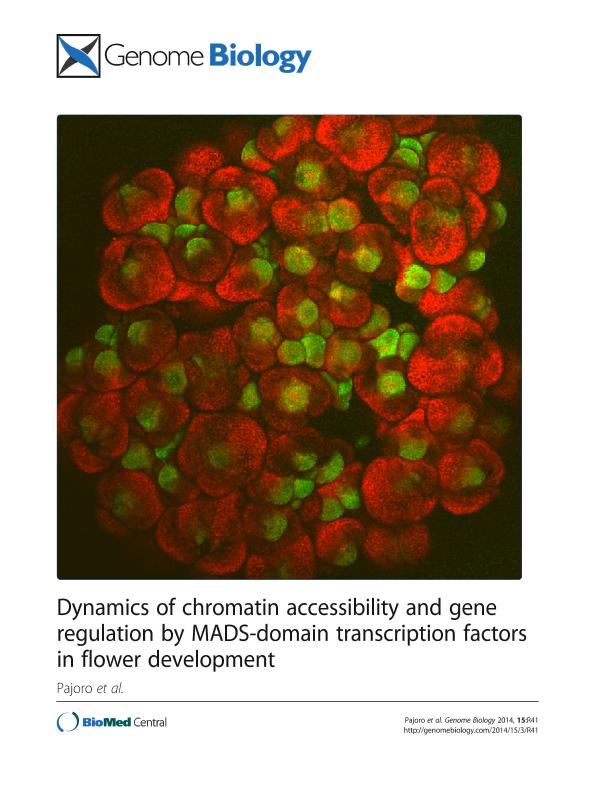Artículo
Dynamics of chromatin accessibility and gene regulation by MADS-domain transcription factors in flower development
Pajoro, Alice; Madrigal, Pedro; Muiño, Jose M.; Matus, José Tomás; Jin, Jian; Mecchia, Martin Alejandro ; Debernardi, Juan Manuel
; Debernardi, Juan Manuel ; Palatnik, Javier Fernando
; Palatnik, Javier Fernando ; Balazadeh, Salma; Arif, Muhammad; Ó’Maoiléidigh, Diarmuid S.; Wellmer, Frank; Krajewsk, Pawel; Riechmann, José Luis ; Angenent, Gerco C.; Kaufmann, Kerstin
; Balazadeh, Salma; Arif, Muhammad; Ó’Maoiléidigh, Diarmuid S.; Wellmer, Frank; Krajewsk, Pawel; Riechmann, José Luis ; Angenent, Gerco C.; Kaufmann, Kerstin
 ; Debernardi, Juan Manuel
; Debernardi, Juan Manuel ; Palatnik, Javier Fernando
; Palatnik, Javier Fernando ; Balazadeh, Salma; Arif, Muhammad; Ó’Maoiléidigh, Diarmuid S.; Wellmer, Frank; Krajewsk, Pawel; Riechmann, José Luis ; Angenent, Gerco C.; Kaufmann, Kerstin
; Balazadeh, Salma; Arif, Muhammad; Ó’Maoiléidigh, Diarmuid S.; Wellmer, Frank; Krajewsk, Pawel; Riechmann, José Luis ; Angenent, Gerco C.; Kaufmann, Kerstin
Fecha de publicación:
03/2014
Editorial:
Biomed Central
Revista:
Genome Biology
ISSN:
1474-760X
Idioma:
Inglés
Tipo de recurso:
Artículo publicado
Clasificación temática:
Resumen
Background: Development of eukaryotic organisms is controlled by transcription factors that trigger specific and global changes in gene expression programs. In plants, MADS-domain transcription factors act as master regulators of developmental switches and organ specification. However, the mechanisms by which these factors dynamically regulate the expression of their target genes at different developmental stages are still poorly understood. Results: We characterized the relationship of chromatin accessibility, gene expression, and DNA binding of two MADS-domain proteins at different stages of Arabidopsis flower development. Dynamic changes in APETALA1 and SEPALLATA3 DNA binding correlated with changes in gene expression, and many of the target genes could be associated with the developmental stage in which they are transcriptionally controlled. We also observe dynamic changes in chromatin accessibility during flower development. Remarkably, DNA binding of APETALA1 and SEPALLATA3 is largely independent of the accessibility status of their binding regions and it can precede increases in DNA accessibility. These results suggest that APETALA1 and SEPALLATA3 may modulate chromatin accessibility, thereby facilitating access of other transcriptional regulators to their target genes. Conclusions: Our findings indicate that different homeotic factors regulate partly overlapping, yet also distinctive sets of target genes in a partly stage-specific fashion. By combining the information from DNA-binding and gene expression data, we are able to propose models of stage-specific regulatory interactions, thereby addressing dynamics of regulatory networks throughout flower development. Furthermore, MADS-domain TFs may regulate gene expression by alternative strategies, one of which is modulation of chromatin accessibility
Palabras clave:
Mads Box
,
Chromatin Remodelling
,
Mir396
,
Grf
Archivos asociados
Licencia
Identificadores
Colecciones
Articulos(IBR)
Articulos de INST.DE BIOLOGIA MOLECULAR Y CELULAR DE ROSARIO
Articulos de INST.DE BIOLOGIA MOLECULAR Y CELULAR DE ROSARIO
Citación
Pajoro, Alice; Madrigal, Pedro; Muiño, Jose M.; Matus, José Tomás; Jin, Jian; et al.; Dynamics of chromatin accessibility and gene regulation by MADS-domain transcription factors in flower development; Biomed Central; Genome Biology; 15; 3; 3-2014; 1-18
Compartir
Altmétricas



